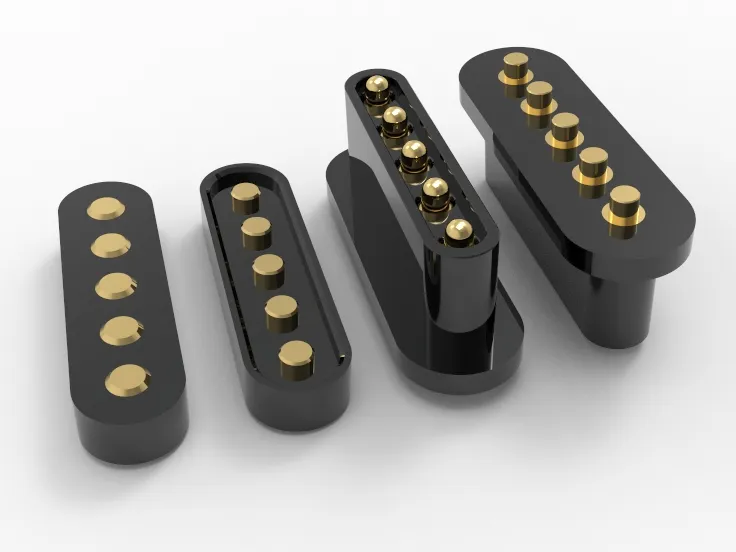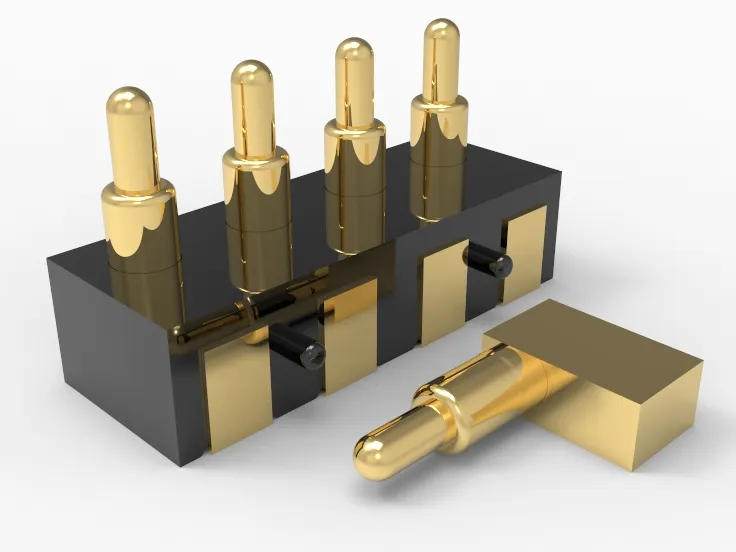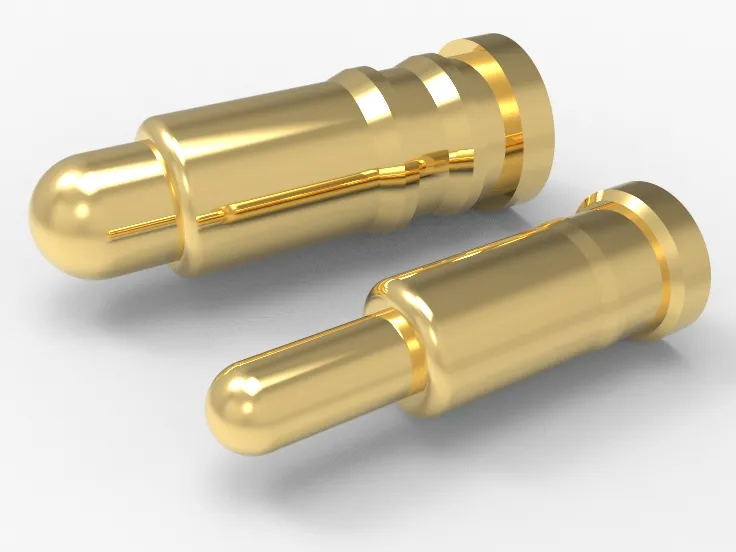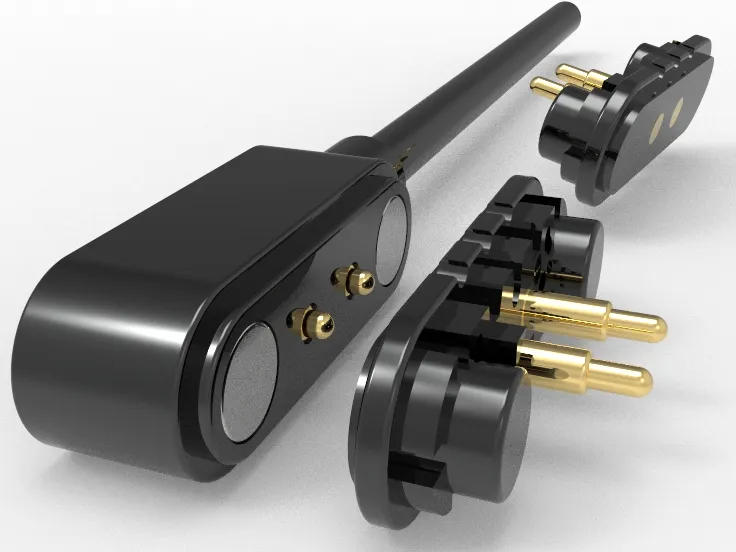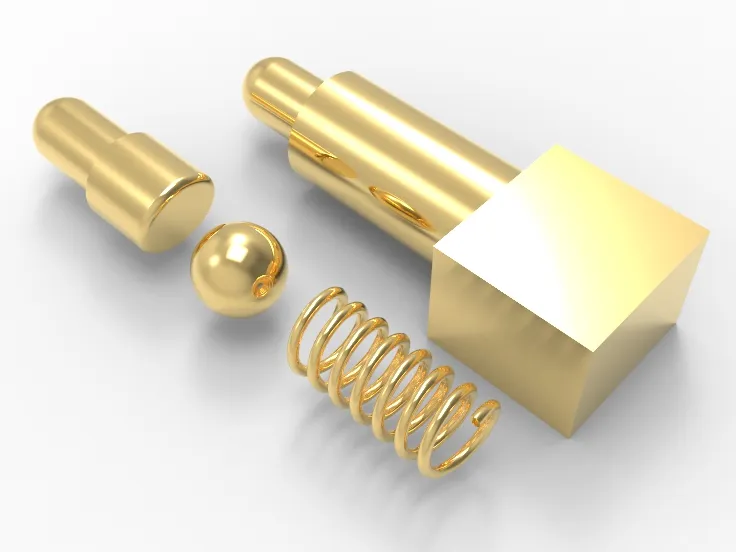Raw Materials Define Johoty’s Pogo Pins Quality. Uncover How the Choice of Materials Affects the Performance and Reliability of Pogo Pins
Introduction
- In electronics, high-quality Pogo Pins are widely used in various devices due to their excellent performance and reliability. The quality of Pogo Pins depends not only on their design and manufacturing but also significantly on the choice of raw materials. The properties and quality of these materials directly affect the performance, durability, and behavior of Pogo Pins in extreme environments.
- Top-grade raw materials offer better conductivity, higher elasticity, and stronger wear resistance, ensuring stable electrical contact even with frequent connections and disconnections. Specifically, material selection involves conductive materials (like high-purity copper alloys), insulating materials (such as high-performance plastics), and spring materials (like premium stainless steel). The physical and chemical characteristics of these raw materials are crucial for the overall quality of Pogo Pins.
- This blog will explore how these key raw materials impact Pogo Pins’ performance in different applications. We will analyze conductivity, mechanical strength, corrosion resistance, and long-term stability to help readers understand how choosing the right raw materials can optimize Pogo Pins’ performance and reliability.
Basic Structure of Pogo Pins
As vital contact components, the quality of Pogo Pins directly affects circuit connection stability and reliability. Johoty’s Pogo Pins are favored for their exceptional performance and reliability, thanks to the precise selection and processing of high-quality raw materials:
1. Plunger:
- Raw Material: Plungers are typically made from highly conductive alloys like copper-nickel, phosphor bronze, tellurium copper, and beryllium copper. These raw materials ensure excellent electrical conductivity while providing sufficient mechanical strength for repeated insertions and removals.
- Processing: Plungers undergo precision machining and surface treatment to enhance wear resistance and corrosion protection, ensuring long-term stable electrical connections.
2. Spring:
- Raw Material: High-quality Pogo Pins use top-grade stainless steel or spring steel for springs, which offer great elasticity and fatigue resistance.
- Design: Springs must be precisely designed to ensure consistent pressure with each contact, providing reliable force and stable performance over time.
3. Insulator:
- Raw Material: Insulators are typically made from strong plastics or ceramics, known for their excellent insulation and heat resistance.
- Function: Insulators prevent electrical shorts and offer mechanical support, keeping the pin and spring in place.
4. Barrel:
- Raw Material: Barrels are made from durable metal alloys or engineering plastics, providing protection and preventing damage during use.
- Structure: The design focuses on heat dissipation and stability to maintain performance under high temperatures or loads.
5. Plunger Tip:
- Raw Material: Tips are usually coated with gold or silver on copper alloys for excellent electrical contact and oxidation resistance.
- Design: The tip design minimizes contact resistance to ensure stable signal transmission.
Collaboration: These components work together through precise design and manufacturing to ensure top performance. The plunger and spring provide elastic contact, the insulator supports and protects, the barrel shields from external damage, and the plunger tip ensures reliable electrical connections.
Raw Material Choices:
- Nickel-Titanium Alloy: Great at resisting corrosion and bouncing back, ideal for high-end electronics like medical and aerospace gear.
- Stainless Steel 304: Tough and corrosion-resistant, perfect for everyday industrial use where frequent unplugging happens.
- Tungsten Alloy: Extremely hard and wear-resistant, best for heavy-duty automation equipment.
- Copper-Nickel Alloy: Excellent conductivity and corrosion resistance, used in high-frequency communication and computing.
- Gold Alloy: Top-notch conductivity and oxidation resistance, suited for precision electronics like medical devices.
- Titanium Alloy: Built to be both strong and light, making it just right for aerospace projects that require durability without adding extra weight.
- Zinc-Nickel Alloy: Good corrosion and wear resistance, used in automotive parts for long-term reliability.
- Copper-Nickel-Tin Alloy: Great electrical performance and mechanical strength, used in stable electronic products.
- Carbon Steel: Budget-friendly for general industrial use; corrosion resistance is lower but can be improved with zinc coating.
- Cobalt Alloy: High wear and heat resistance, suitable for extreme temperature applications.
- Silver Alloy: Extremely conductive and corrosion-resistant, used in high-frequency electronics for reliable performance.
How Raw Materials Affect Pogo Pins Performance?
- Conductivity: High-quality raw materials like pure copper or nickel plating boost Pogo Pins’ electrical conductivity, ensuring stable and fast signal transmission.
- Wear Resistance: Durable alloy raw materials extend Pogo Pins’ lifespan, reduce wear on contact points, and keep them reliable over time.
- Elasticity: Top-notch stainless steel or alloys provide the best elasticity, maintaining good contact pressure even with frequent use.
- Corrosion Resistance: Raw materials with excellent anti-corrosion properties, like nickel or gold plating, prevent rust and extend the pins’ life in harsh environments.
- Thermal Stability: Quality materials maintain Pogo Pins’ performance across temperature extremes, preventing issues from temperature changes.
- Size Stability: Stable-sized raw materials ensure Pogo Pins’ accuracy, avoiding poor contact due to material expansion or contraction.
- Mechanical Strength: High-strength alloys enhance Pogo Pins’ structural stability, reducing the chance of deformation during use.
- Electrical Insulation: Good insulation raw materials prevent electrical shorts or leaks, improving the safety and reliability of Pogo Pins.
- Manufacturing Consistency: Using consistent, high-quality raw materials ensures uniform performance across different batches, avoiding quality variations.
- Environmental Adaptability: High-quality raw materials handle various environmental conditions like humidity and chemicals, keeping Pogo Pins performing well in different applications.
Standards for High-Quality Pogo Pins
Raw Material Selection Criteria:
- Conductivity: Use high-purity copper or gold-plated raw materials for reliable signal transmission.
- Wear Resistance: Choose alloys like phosphor bronze or stainless steel for durability and reduced wear.
- Elastic Recovery: High-quality pogo pins need raw materials with excellent elasticity, like tungsten alloys, to maintain consistent spring action.
- Corrosion Resistance: Use corrosion-resistant raw materials or treatments, such as nickel or gold plating, to ensure longevity.
- Dimensional Accuracy: High-precision raw materials ensure consistent size and accurate fitting during production.
- Heat Resistance: Use materials like tantalum alloys for performance stability under high temperatures.
- Insulation: High-quality plastic or ceramic raw materials provide excellent insulation to prevent electrical shorts and interference.
- Spring Performance: Select raw materials with high elasticity and fatigue life for reliable long-term performance.
Manufacturing Process:
- Material Purity: Using high-grade raw materials like pure copper alloys or stainless steel reduces impurities, enhancing the conductivity and corrosion resistance of Pogo Pins for better performance and durability.
- Hardness and Elasticity: High-quality raw materials are carefully controlled for hardness and elasticity, ensuring Pogo Pins maintain consistent bounce and avoid early fatigue or deformation.
- Surface Treatment: Premium raw materials often undergo advanced treatments like plating or polishing to improve wear resistance and oxidation resistance, making Pogo Pins more reliable.
- Conductivity: Choosing raw materials with good conductivity (like high-conductivity copper) boosts the electrical efficiency of Pogo Pins, reducing contact resistance and improving device performance.
- Thermal Stability: Top-quality raw materials have excellent thermal stability, maintaining performance in high temperatures and preventing performance drop due to temperature changes.
- Mechanical Strength: High-quality raw materials have higher mechanical strength, allowing Pogo Pins to endure more physical pressure without structural damage.
- Corrosion Resistance: Premium stainless steel or nickel-plated raw materials offer strong corrosion resistance, keeping performance stable in moist or corrosive environments and extending lifespan.
- Processing Precision: Top raw materials are processed more precisely, ensuring consistent size and shape of Pogo Pins for accurate assembly and stable contact.
- Consistency: Using high-quality raw materials ensures consistent performance across Pogo Pins, avoiding performance fluctuations or failures due to uneven material quality.
- Long-term Reliability: High-quality raw materials offer stable long-term performance, reducing the failure rate of Pogo Pins and improving overall product reliability and user satisfaction.
These standards ensure Pogo Pins deliver high performance and long life in real-world applications, providing reliable electrical connections and stable operation.
Case Study
- Beryllium Copper: A copper blend that includes a touch of beryllium. It has excellent electrical and thermal conductivity, high elasticity, and great hardness, making it ideal for high-frequency and high-current applications. It’s durable against mechanical shock and wear, and suited for high-end electronics and communication devices. However, beryllium is toxic, so handling requires caution.
- Tellurium Copper: Copper mixed with tellurium to make it easier to machine and boost its performance. It offers excellent cutting performance and good conductivity, ideal for precise manufacturing. While its corrosion resistance is not as strong as other alloys, its machining and electrical properties make it popular in precision electronics.
- Stainless Steel 304: An austenitic stainless steel known for good corrosion resistance and high-temperature performance. It provides mechanical strength and durability, making it suitable for harsh environments. Its electrical performance is average, but it excels in physical strength and long-term durability for industrial and outdoor connectors.
- Stainless Steel 316: It is a grade of steel that resists rust exceptionally well, especially in salty or chlorinated conditions. It has added molybdenum compared to 304 stainless steel, making it better for marine and chemical use. For Pogo Pins, 316 is great because it performs well even in harsh conditions, so it’s commonly used in electronics that face severe corrosion.
- Titanium Alloy: it is prized for being both strong and lightweight, and it resists rust well, making it perfect for top-notch performance uses. Titanium Alloy Pogo Pins can handle extreme temperatures and harsh environments while staying reliable. Its light weight and high strength make it perfect for aerospace, military, and high-end electronics, but it is expensive and used only where top performance is needed.
- Cobalt Alloy: It is a high-performance material made mostly of cobalt, with some chromium and nickel. It’s great for high temperatures and wear resistance, offering excellent durability and stability in tough conditions. For Pogo Pins, Cobalt Alloy provides great wear resistance and longevity, suitable for demanding industrial uses. However, it’s difficult and costly to process, so it’s used only when necessary.
- Chromium Alloy: has a high chromium content, giving it strong wear and corrosion resistance. Chromium Alloy Pogo Pins last longer in high-wear and corrosive environments. They’re hard and resist oxidation, making them good for harsh settings like high-temperature industrial uses or durable electronics. However, it’s less tough, so it might not be ideal where flexibility is needed.
- Nitinol (Nickel-Titanium Alloy): Nitinol is a special metal that “remembers” its shape and returns to it when temperatures change. This makes Nitinol Pogo Pins reliable even in high heat, offering great flexibility and durability. It’s ideal for high-end uses like medical devices and aerospace equipment where dependable connections and self-healing features are needed.
- Tungsten Alloy: Tungsten Alloy is very dense and hard, making it incredibly durable under extreme conditions. Tungsten Pogo Pins perform well in high temperatures and pressures and resist wear and impact. They’re used in military and high-performance electronics where extreme durability and stability are crucial. Though costly and challenging to process, Tungsten is reserved for top-tier applications.
- Gold Alloy: This alloy of gold is known for being a top conductor and resisting oxidation, so it’s commonly used in electronic devices. Gold Pogo Pins offer superb electrical performance and long-term stability, with corrosion resistance suited for high-precision and reliable electronic devices. Despite its higher cost, its superior conductivity and stability make it a top choice for high-end electronics and precision instruments.
Conclusion:
- Choosing the right raw materials is crucial in making high-quality Pogo Pins. Johoty ensures every step, from sourcing materials to production, meets high standards for performance and reliability. From highly conductive alloys to wear-resistant raw materials, we strive to meet and exceed market demands.
- The choice of raw materials directly affects the electrical performance, lifespan, and stability of Pogo Pins, and Johoty’s commitment to quality keeps us at the forefront of the industry.








